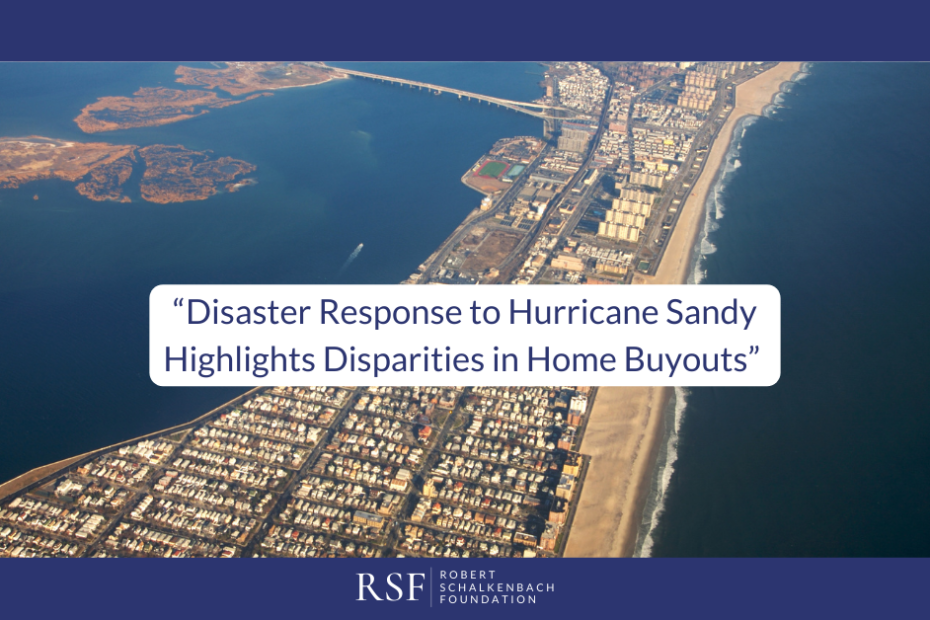New York received record-breaking rainfall in 2023, which led to flooding in coastal and urban areas. As the state grapples with recurring flooding issues, residents are reminded of Hurricane Sandy in 2012, where governments were challenged with the displacement of thousands of families and damage to 650,000 homes in the Northeastern United States, especially in New York.
The storm caused the most damage to the most disadvantaged populations: low-income families, public housing residents, and people of color who were already burdened by industrial pollution problems. In addition to New York City (Queens and Long Island), the hardest hit counties were Suffolk, Nassau, Westchester, and Rockland, all of which contain multiple superfund sites — areas categorized by the U.S. Environmental Protection Agency as posing a risk to human health due to toxic waste pollution from improper hazard management or dumping.
In addition to over $6 billion from the Federal Emergency Management Agency (FEMA), New York received $4.4 billion of Community Development Block Grant – Disaster Recovery (CDBG-DR) funding from the U.S. Department of Housing and Urban Development (HUD). CDBG-DR helps rebuild affected disaster areas and funding can extend to home buyouts and relocation incentives, if the awardee’s initiatives either 1) primarily benefit low-and moderate income individuals 2) prevents and eliminates slums or the decay of urban communities, or 3) meets other urgent community development needs directly impacting community health or welfare; and other financial resources are not available to meet such needs.
A major proportion of CDBG-DR funding was used for New York’s Home Buyout Program, which offered victims the market-value for their homes before Hurricane Sandy and options to relocate to safer areas less prone to flooding. The program received mixed reactions from constituents, but by 2018, 1,519 (75%) of eligible properties were either in the buyout process or already sold.
However, The New York Times reported in 2013 that around $40 million in CDBG-DR funding for Hurricane Sandy was used for the state’s “Open For Business” ad campaign, a marketing initiative spear-headed by former Governor Andrew Cuomo. One segment consisted of a series of ads aimed to promote tourism and patronage of small businesses in areas impacted by Hurricane Sandy. According to NYC’s recovery action plan, the state began running ads on small businesses in 2013.
Although Cuomo’s name or likeness did not appear in these ads, critics, including his Republican rival at the time, Rob Astorino, scrutinized the campaign as misuse of federal aid and an indirect way to promote himself for re-election. Whether the Open For Business campaign met at least one of the criteria for CDBG funding is debatable, yet there was potential to allocate $40 million CDBG-DR funds to increase the number of households eligible for the home buyout program, or provide housing assistance to renters.
Research suggests that buyouts can be an effective solution for flood prone communities, which could save taxpayers billions or more in disaster recovery spending in the long run and prevent loss and damage to residences in flood-prone areas. However, investigations demonstrated that White communities nationwide have disproportionately received more federal buyouts after a disaster than communities of color; and that buyouts favor the rich. One of the biggest problems with the home buyout program is that it can only benefit homeowners. In 2012, home ownership rates for Black and White people in New York State were 44% and 70%, and even less in New York City.
Although the program had a 75% participation rate, a 2018 report showed that zero homes were bought out in Queens, although the Rockaway Peninsula in Queens was almost completely submerged by the Hurricane. In 2010, there were 47,462 housing units on the strip, but Rockaway’s homeownership rate was only 37.8%, forcing renters to rely on FEMA’s Individual Assistance Program and HUD’s Disaster Housing Assistance Program, which could only provide temporary housing assistance, rather than long-term stability, which the buyout program aimed to provide.
In addition, some promises of the buyout program were not kept. In Oakwood Beach, families whose homes were bought out were promised that the land would be returned to nature. Instead, six acres of land were transferred to the Staten Island Soccer League in 2019, where they plan to build a soccer complex with up to six fields.
Ten years after Hurricane Sandy, New York voters approved $1 billion in new funding for more home buyouts in flood-prone areas and coastline protection in another flood mitigation program. As New York continues to flood even during heavy rainfall, flood mitigation programs will be crucial in the coming years. Still, the lack of follow-through from city officials and questionable allocation of aid dollars highlight the need for increased equity and transparency in disaster response throughout the U.S.

